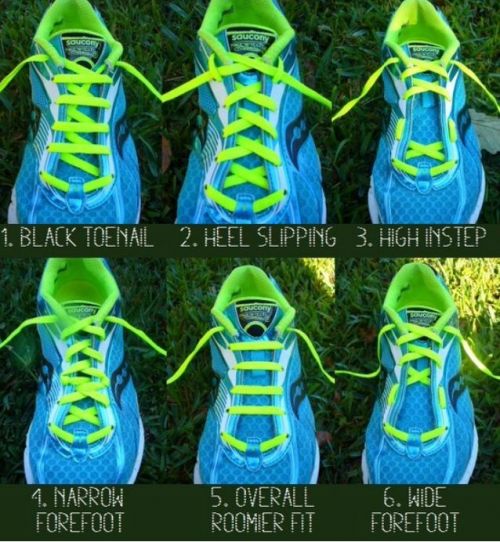There are nine basic types of Track Shoes:
Any spike over $80 is generally not meant for everyday use, just for racing. Track Types:
Jumping runways and aprons are usually rubber or asphalt so wear short needle spikes. Javelin can be grass (use long pyramid), or any other surface mentioned above. Spike Types:
Always ask your coach if the meet you are going to has any spike requirements. Training Shoes: Running shoes are the only shoes in the industry designed to meet the individual athlete's needs. Have flat feet? No problem, the running shoe industry has a model to address this. High arches, wide feet, narrow heel? No worries, there is a model out there that will help you get through your run. The catch is to find a particular design that addresses YOUR needs. Once you determine what those needs are, then you just need to find a model that has the features you want and stick with it. Many runners buy the latest fad shoe because it looks cool only to discover that the model "makes their feet hurt". This is usually because the shoe they purchased was designed with someone else in mind. All the design features listed below concern themselves with the midsole (the foam piece of material between the upper and the outsole). The midsole is the portion of the shoe that shoe designers tinker with to add support where you need it. So without further ado, here are the basic features and what they accomplish. Midsole: The foam piece between the upper and the outsole. This is usually made of CMEVA (compression molded EVA). The amazing thing about midsoles is that they differ in densities. Some are very soft while others are firm. This material can also be formed to just about any design a company wants. In recent years, midsoles have been designed to wrap around the heel of the shoe to add stability. Additionally, the midsole can be combined with plastic pieces to increase stability (see medial post below). Medial Post: This is the area of the midsole on the inside heel portion that is made harder or more dense to prevent your heel from rolling towards the inside (pronation). Companies take different approaches to this theory. Some use a plastic piece and denser midsole materials or use denser materials alone. In either case, this is the feature you need if you pronate. The amount of medial post depends on the severity of your over-pronation. As the severity of overpronation increases, so do the medial posts. The next step are the models such as the Nike Air Structure triax and New Balance 851 which curb most over-pronation problems. In the case of severe over-pronators or those heavier runners with slight over-pronatation problems, models such as the Brooks Beast are the only option. Big, heavy and possessing a very dense midsole, these shoes act as a cast on the foot preventing overpronation in even the most severe cases. Cushioning Technology: Air, Gel, adiprene, Hydroflow, Hexalite, DMX, Absorb are all terms the shoe companies use to advertise their cushioning technology. Designers place this technology in key areas to decrease the impact of running. Some shoes do not possess any technology, some have it only in the heel, some in the heel and forefoot and still others the full length of the shoe. What's right for you? Is one better than the other? What you want to do is purchase a shoe that has at the very least some form of technology in the heel. For those who feel the need for additional forefoot cushioning, purchase a model that has technology in the forefoot. A word of warning: the more technology a shoe has, the more it will cost. Outsole: Years ago when outsoles would wear out in 150-200 miles, everyone ran down to buy Shoe-goo to increase outsole life. Those days are pretty much gone. In fact, most outsoles last longer than the midsole. This makes it extremely important to log the miles you have on your shoes. Most midsoles last between 400-600 miles. This is the part of the shoe that provides the cushioning and support to keep you injury free. Don't make the mistake of running on worn out shoes simply because the outsole isn't worn through. You're risking injuries. Type of Foot Plant: The features described above come into play when you determine one very important fact, what type of foot strike do you have? You've probably seen described in running magazines or running shoe catalogs the drawings showing an overpronating foot or a neutral foot or an underpronating foot. The problem is that in looking at the pictures, most people assume that they need to land on the inside portion of the heel to be an overpronator, but this is absolutely WRONG. Let me repeat, you can land on the outside portion of the heel and be an overpronator. In fact, this is what most overpronators do. So how do you determine what your foot strike is? You start by looking at the outsole wear of your old shoes (here's how we do it in the store). Ninety-five percent of all runners land on the outside edge of the heel, so this really tells us little. What you need to do is look at the wear of the forefoot area of the shoe. Overpronator: Forefoot wear is exclusively under the big toe and ball of the foot area. In severe cases, the wear will be exclusively under the ball of the foot and towards the inside (medial area) of the shoe. Diagnosis: Because all of the force of the overpronator's weight is directed over the medial/inside portion of the shoe after heel plant, it becomes very important to purchase a shoe with a medial post. The more severe the inside force, the greater the need for a medial post. Neutral: Forefoot wear is directed straight down the middle of the forefoot. Most of the wear will occur right between the second and third toes. Underpronator: Forefoot wear is directed primarily towards the outside edge of the forefoot under the pinky toe. Forefoot Striker: Forefoot wear will concentrate itself at the ball of the foot under the entire width of the shoe. This shoe will also show little to no wear at the heel. Categories of shoes Motion Control: For those severe overpronators or heavy runners with slight to severe overpronation problems. Medial posts are extreme. Most possess technology in the heel and forefoot. Very heavy and not recommended for fast paced training. Stability: The category of shoe for most runners who overpronate. These shoes feature longer medial posts (some with plastic pieces to enhance this feature), technology in the heel and usually the forefoot. Core: This category is moderately priced, has a smaller medial post, heel technology and is a great place to start if you're a beginning runner without any history of shoe wear to examine foot plant. Cushion: This category places a premium on cushioning and has few stability features. These shoes are designed for neutral and underpronation runners who desire a very soft ride. Lightweight: For those runners who want a different trainer for faster runs or workouts. These are shoe designed for fast training. Wear and support are secondary considerations. Racing Flats: Designed with one thing in mind, speed. Don't expect long life or support from these models. Minimal design features make these shoes light weight. Lacing help:  |



